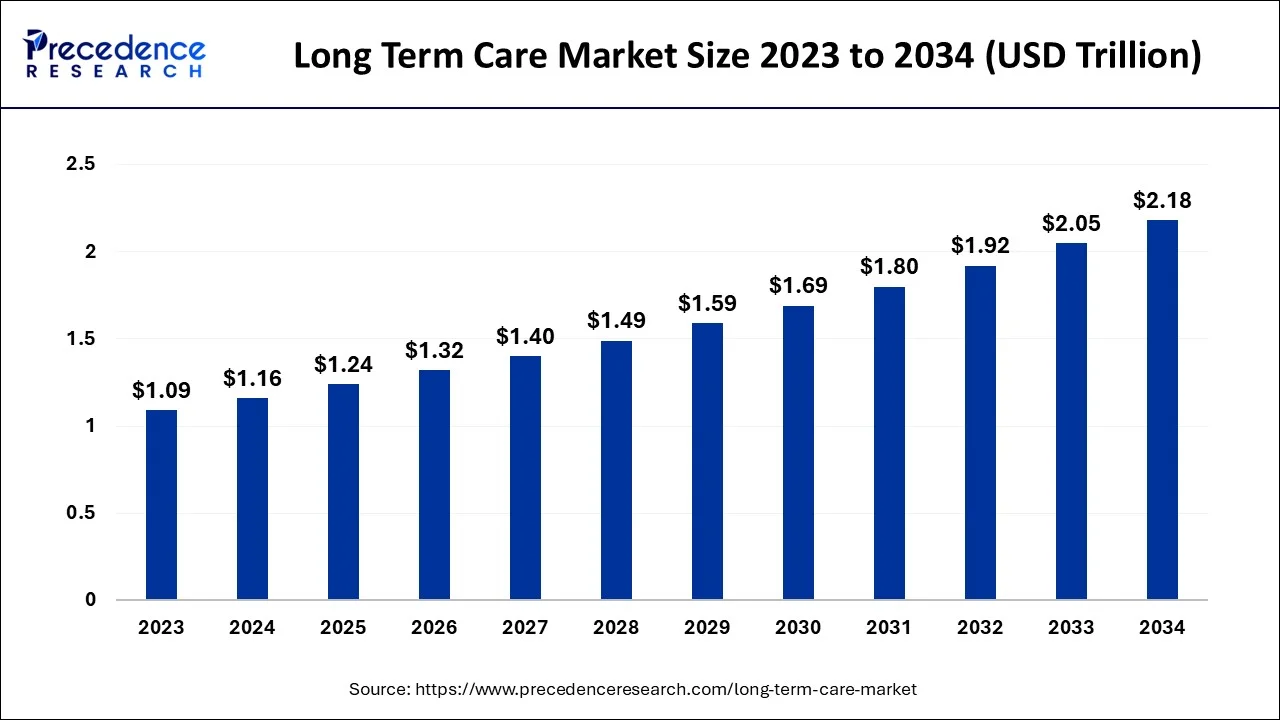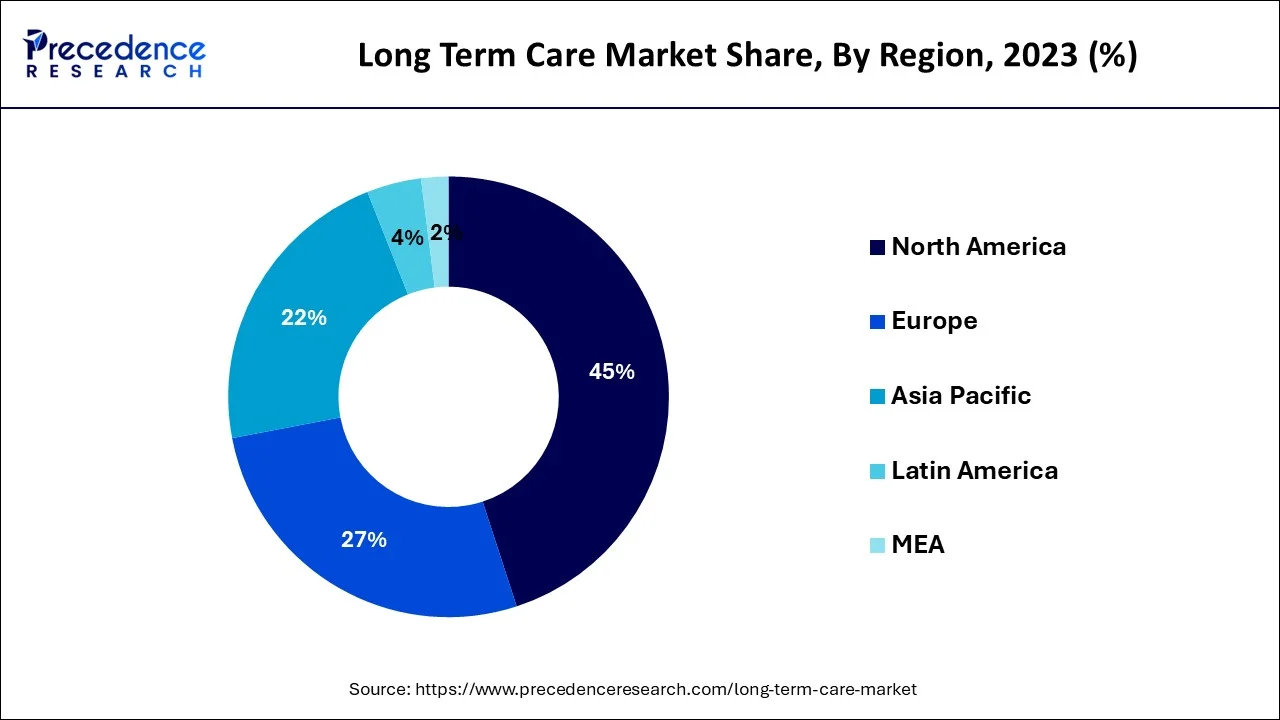July 2024
The global long term care market size is estimated at USD 1.16 trillion in 2024, grew to USD 1.24 trillion in 2025 and is predicted to surpass around USD 2.18 trillion by 2034, expanding at a CAGR of 6.50% between 2024 and 2034.
The global long term care market size accounted for USD 1.16 trillion in 2024 and is anticipated to reach around USD 2.18 trillion by 2034, expanding at a CAGR of 6.50% between 2024 and 2034.

Based on the region, the North America segment dominated the market share 45% in 2023. This is attributed to the growing geriatric population. The factors such as implementation of rules and regulations and high government investments are contributing towards the growth of long term care market in North America region.

The Asia-Pacific is projected to grow at a CAGR of 8.5% during the forecast period. This is attributed to an increasing rate of chronic illnesses such as heart disease, diabetes, and respiratory ailments. The long term care market is still in the beginning stage. Furthermore, foreign long term care facilities are making investments in nations like India.
Long term care is support for older people who are unable to care for themselves owing to physical or mental illnesses, such as chronic disease and multimorbidity. Depending on the degree of constraint, assistance with daily living activities such as medication management, dressing, and basic health services might be provided at home, in the community, or in institutions. Formal and informal laborers, paid or unpaid, typically provide these services. Formal professionals could include competent health or social workers who work in nursing homes. Unpaid family caregivers and paid caregiver who labor outside of formal employment norms and are not reported to social security authorities are classified as informal caregivers.
Long term care includes a variety of levels of care and places, including adult day care, nursing homes, hospices, and home health care. The demand for the global long term care market has been impacted by a variety of elements and aspects. The individual’s health and functional state had a significant impact in determining the options they believe are valuable. Apart from that, the availability of resources is the most important factor in determining their decisions.
The health, personal, support services are included in home-based long term care to enable people to stay at home and live as independently as possible. The majority of long term care is provided in the home of the individual receiving services or at the home of a family member. In-home services can be short term or long term.
Personal care, such as assistance with dressing, bathing, and taking medications, is common among home-based services, as is supervision to ensure a person’s safety. The majority of this form of care is provided by unpaid family members, partners, friends, and neighbors.
Long term care has been in high demand among the older population, and services are now widely available in industrialized countries. Due to changes in care settings and needs, new demands have evolved in the long term care market in many situations, defining the preferences of target populations. As a result, the long term care market has broadened due to wide range of options that consider funding and care coordination.
Due to the ageing baby boomers, increasing disabilities among the older population, a shortage of competent nursing staff, government funding, and expanded collaborations between commercial insurers and various governments, the long term care market is predicted to boom. As a result of the longer life expectancy, the number of disability cases has increased. The increasing demand for affordable long term care services for chronic illnesses, memory loss, and post-hospital healthcare is expected to rise as a result of this.
The target demographic for long term care services includes a high number of persons who are sick, disabled, or old. As a result, the growing geriatric population is a major driver of long term care demand. The demand for long term care is also being driven by an increase in the population with chronic ailments or illnesses. The need for adult day care has increased as the number of people with osteoporosis, hypertension, and diabetes has increased in developed countries.
Governments in a number of developing and wealthy countries are enacting policies aimed at extending the productive lives of the elderly. The global long term care market has benefited greatly as a result of this. The nursing homes have gained momentum among those seeking counseling services and mental health in recent years.
| Report Coverage | Details |
| Market Size in 2023 | USD 1.16 Trillion |
| Market Size By 2034 | USD 2.18 Trillion |
| Growth Rate From 2024 to 2034 | CAGR of 6.50% |
| Largest Market | North America |
| Fastest Growing Market | Asia Pacific |
| Base Year | 2023 |
| Forecast Period | 2024 to 2034 |
| Segments Covered | Service, Region |
| Regions Covered | North America, Europe, Asia-Pacific, Latin America and Middle East & Africa |
Based on the service, the nursing care segment is garnering a market share 35% in 2023. A primary factor driving the segment is the presence of huge number of facilities that provide nursing care to the world’s rising ageing population. Thus, this factor is driving the growth of nursing care segment in the long term care market during the forecast period.
The hospice segment is expected to grow at rapid pace 8.5% during the forecast period. The growing need for customized long term care at home, as well as cost-effectiveness, are propelling the home healthcare segment growth. For many individuals in need of care, the home healthcare has become the fact due to rising healthcare costs. As the need for home healthcare grows, healthcare providers are implementing newer technologies and software to increase the quality of long term care services.
Key Companies & Market Share Insights
The market is moderately fragmented with the presence of several local companies. These market players are striving to gain higher market share by adopting different marketing strategies, such as new product launch, investments, partnerships, and mergers & acquisitions. The companies are also spending on the development of improved products. Moreover, they are also focusing on competitive pricing.
In November 2019, the Amedisys acquired a hospice care provider, Asana Hospice in the U.S.
The various developmental strategies such as acquisition, business expansion, investments, new product launches, partnerships,joint venture, and mergers fosters market growth and offers lucrative growth opportunities to the market players.
Segments Covered in the Report
By Services
By Geography
For inquiries regarding discounts, bulk purchases, or customization requests, please contact us at sales@precedenceresearch.com
No cookie-cutter, only authentic analysis – take the 1st step to become a Precedence Research client
July 2024
January 2025
January 2024
September 2024